Cryptosporidiosis NNDSS Summary Report for 2018
Background
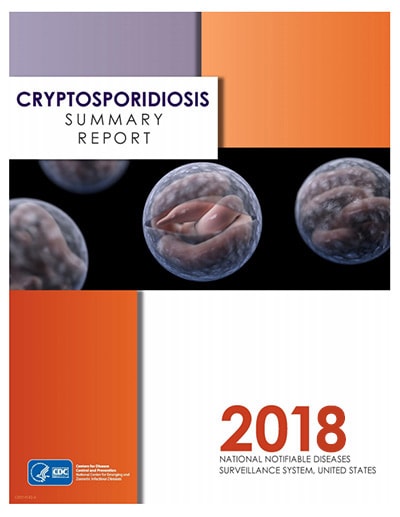
Surveillance Overview: National Cryptosporidiosis Case Surveillance
Cryptosporidiosis is a gastrointestinal illness caused by protozoa of the genus Cryptosporidium, the leading cause of U.S. waterborne disease outbreaks (1) and the third leading cause of U.S. zoonotic enteric illness (2). An estimated 748,000 cryptosporidiosis cases occur annually; this means <2% of cases are nationally notified (3). Cryptosporidium infection can be symptomatic or asymptomatic. Immunocompetent patients can experience frequent, non-bloody, watery diarrhea typically lasting up to 2–3 weeks (4). Additional symptoms can include vomiting, nausea, abdominal pain, fever, anorexia, fatigue, and weight loss. Immunocompromised patients can experience profuse watery diarrhea lasting weeks to months or even life-threatening malnutrition and wasting.
Cryptosporidiosis is a nationally notifiable disease; the first full year of reporting was 1995. National data are collected through passive surveillance. Healthcare providers and laboratories that diagnose cryptosporidiosis are mandated to report cases to the local or state health department. The 50 states, territorial, District of Columbia (DC), and New York City health departments, in turn, voluntarily notify CDC of cases via the National Notifiable Diseases Surveillance System (NNDSS). Some states conduct enhanced molecular surveillance of cryptosporidiosis through participation in CryptoNet; CryptoNet data are not presented here.
State, DC, US territory, and Freely Associated State public health agencies voluntarily notify CDC of cryptosporidiosis outbreaks via the National Outbreak Reporting System (NORS). NORS data are not presented here; however, summaries of data on waterborne disease outbreaks are reported elsewhere.
Methods
Case Definition
The definition of a confirmed case of cryptosporidiosis has changed over time; the first national case definition was published in 1995, and the current case definition was published in 2012. The pre-2011 case definitions classified a case with any laboratory evidence of Cryptosporidium infection as a confirmed case.
The 2012 confirmed case definition requires evidence of Cryptosporidium organisms or DNA in stool, intestinal fluid, tissue samples, biopsy specimens, or other biological sample by certain laboratory methods with a high positive predictive value (e.g., direct fluorescent antibody [DFA] test, polymerase chain reaction [PCR], enzyme immunoassay [EIA], or light microscopy of stained specimen).
A probable case of cryptosporidiosis is defined as 1) having supportive laboratory test results for Cryptosporidium spp. infection using a screening test method, such as immunochromatographic card or rapid card test, or a laboratory test of unknown method or 2) meeting clinical criteria (i.e., diarrhea and one or more of the following: diarrhea duration of >72 hours, abdominal cramping, vomiting, or anorexia) and being epidemiologically linked to a confirmed case.
A suspect case is defined as having a diarrheal illness and being epidemiologically linked to a probable case. Cases not classified as confirmed, probable, or suspect are classified as unknown.
Analysis
National cryptosporidiosis surveillance data for 2018 were analyzed using R version 3.5.1. Data cleaning processes included case deduplication and the verification of case status (e.g., confirmed, nonconfirmed). Numbers, percentages, and incidence (cases per 100,000 population) of cryptosporidiosis were calculated in aggregate for the United States and separately for each reporting jurisdiction. Rates were calculated by dividing the number of cryptosporidiosis cases by mid-year census estimates (5, 6) and multiplying by 100,000. In addition to analyzing data nationally and by reporting jurisdiction, data were analyzed by region (Northeast, Midwest, South, and West regions), as defined by the U.S. Census Bureau (7). To account for differences in the seasonal use of recreational water, the West region was further subdivided into Northwest and Southwest.
To examine reporting over time, cryptosporidiosis rates were calculated by year (1995–2018) and case status (confirmed or nonconfirmed). Average annual cryptosporidiosis rates were calculated by demographic variables (e.g., age and sex). Rates were not calculated for race or ethnicity, because 14.6% of race data and 25.5% of ethnicity data were missing, nor were rates calculated by month of symptom onset. One case reported by Puerto Rico for 2016 was excluded from analysis, because detailed demographic census data are not available to calculate rates by age and sex.
Acknowledgements
The authors thank the Surveillance and Data Branch, Division of Health Informatics and Surveillance, Center for Surveillance, Epidemiology, and Laboratory Services; Office of Public Health Scientific Services, Centers for Disease Control and Prevention, U.S. Department of Health and Human Services, Atlanta, GA for preparing and aggregating state-based NNDSS data for dissemination.
Tables and Figures
Figure 1. Incidence* of cryptosporidiosis cases, by year and case classification — National Notifiable Diseases Surveillance System, United States, 1995¶–2018 (n=167,642)
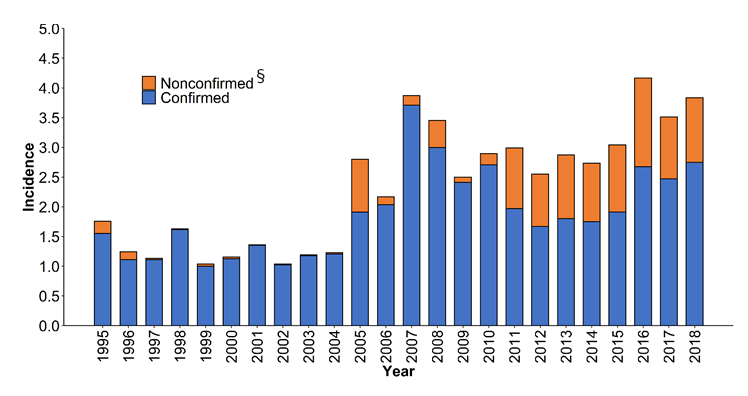
* Cases per 100,000 population per year
§ Probable, suspect, or unknown cases
¶ First full year of national reporting
After 2004, the overall annual incidence rate of cryptosporidiosis has remained greater than 2.0 per 100,000 population. It is unclear if this reflects a true increase or one or more of the following: U.S. Food and Drug Administration’s 2005 approval of nitazoxanide to treat cryptosporidiosis in immunocompetent patients ages >12 years and substantial outbreaks (each resulting in >2,000 cases) that occurred in 2005 (NYS), 2007 (UT), 2008 (TX), and 2016 (OH). After 2015, testing for Cryptosporidium increased due to increasing use of diagnostic multiplex PCR panels for gastrointestinal illness. Additionally, the incidence of cryptosporidiosis outbreaks substantially increased in 2016. The consistently increased rate of nonconfirmed cases after 2010 likely reflects changes in the national case definition.
Table 1. Number, percentage*, and incidence§ of cryptosporidiosis cases, by region and jurisdiction — National Notifiable Diseases Surveillance System, United States, 2018 (n=12,540)
| Region/Jurisdiction | No. | % | Incidence | No. of outbreak- associated cases |
|---|---|---|---|---|
| Northeast | 1,819 | 14.5 | 3.2 | 86 |
| Connecticut | 81 | 0.6 | 2.3 | |
| Maine | 60 | 0.5 | 4.5 | |
| Massachusetts | 242 | 1.9 | 3.5 | 6 |
| New Hampshire | 87 | 0.7 | 6.4 | 7 |
| New Jersey | 164 | 1.3 | 1.8 | |
| New York City¶ | 248 | 2.0 | 3.0 | 1 |
| New York State¶ | 323 | 2.6 | 2.9 | 8 |
| Pennsylvania | 457 | 3.6 | 3.6 | 11 |
| Rhode Island | 90 | 0.7 | 8.5 | 53 |
| Vermont | 67 | 0.5 | 10.7 | |
| Midwest | 4,654 | 37.1 | 6.8 | 81 |
| Illinois | 425 | 3.4 | 3.3 | 14 |
| Indiana | 324 | 2.6 | 4.8 | 1 |
| Iowa | 663 | 5.3 | 21.0 | |
| Kansas | 95 | 0.8 | 3.3 | |
| Michigan | 378 | 3.0 | 3.8 | 3 |
| Minnesota | 530 | 4.2 | 9.4 | 39 |
| Missouri | 351 | 2.8 | 5.7 | |
| Nebraska | 170 | 1.4 | 8.8 | |
| North Dakota | 39 | 0.3 | 5.1 | |
| Ohio | 640 | 5.1 | 5.5 | 24 |
| South Dakota | 177 | 1.4 | 20.1 | |
| Wisconsin | 862 | 6.9 | 14.8 | |
| South | 3,920 | 31.3 | 3.1 | 148 |
| Alabama | 152 | 1.2 | 3.1 | 5 |
| Arkansas | 82 | 0.7 | 2.7 | |
| Delaware | 31 | 0.2 | 3.2 | |
| District of Columbia | 36 | 0.3 | 5.1 | |
| Florida | 586 | 4.7 | 2.8 | 91 |
| Georgia | 350 | 2.8 | 3.3 | |
| Kentucky | 178 | 1.4 | 4.0 | 1 |
| Louisiana | 157 | 1.3 | 3.4 | |
| Maryland | 85 | 0.7 | 1.4 | |
| Mississippi | 98 | 0.8 | 3.3 | |
| North Carolina | 263 | 2.1 | 2.5 | 2 |
| Oklahoma | 164 | 1.3 | 4.2 | |
| South Carolina | 121 | 1.0 | 2.4 | |
| Tennessee | 251 | 2.0 | 3.7 | 4 |
| Texas | 983 | 7.8 | 3.4 | 44 |
| Virginia | 312 | 2.5 | 3.7 | 1 |
| West Virginia | 71 | 0.6 | 3.9 | |
| Northwest | 739 | 5.9 | 4.7 | 12 |
| Alaska | 17 | 0.1 | 2.3 | |
| Idaho | 129 | 1.0 | 7.4 | 10 |
| Montana | 81 | 0.6 | 7.6 | |
| Oregon | 297 | 2.4 | 7.1 | |
| Washington | 198 | 1.6 | 2.6 | 2 |
| Wyoming | 17 | 0.1 | 2.9 | |
| Southwest | 1,408 | 11.2 | 2.3 | 41 |
| Arizona | 203 | 1.6 | 2.8 | 18 |
| California | 663 | 5.3 | 1.7 | |
| Colorado | 215 | 1.7 | 3.8 | 1 |
| Hawaii | 7 | 0.1 | 0.5 | |
| Nevada | 38 | 0.3 | 1.3 | |
| New Mexico | 89 | 0.7 | 4.2 | 11 |
| Utah | 193 | 1.5 | 6.1 | 11 |
| Total | 12,540 | 100 | 3.8 | 368 |
* Percentages might not total 100% because of rounding
§ Cases per 100,000 population
¶ New York State and New York City data are mutually exclusive
By jurisdiction, incidence ranged from 21.0 per 100,000 population in Iowa to 0.5 per 100,000 population in Hawaii. As a region, the Midwest has the greatest overall incidence of 6.8 per 100,000 population. This coincides with this region having some of the highest incidence by jurisdiction. Differences in incidence might reflect differences in risk factors or mode of transmission of Cryptosporidium; the magnitude of outbreaks; or the capacity or requirements to detect, investigate, and report cases.
Figure 2. Incidence* of cryptosporidiosis cases, by jurisdiction — National Notifiable Diseases Surveillance System, United States, 2018 (n=12,540)
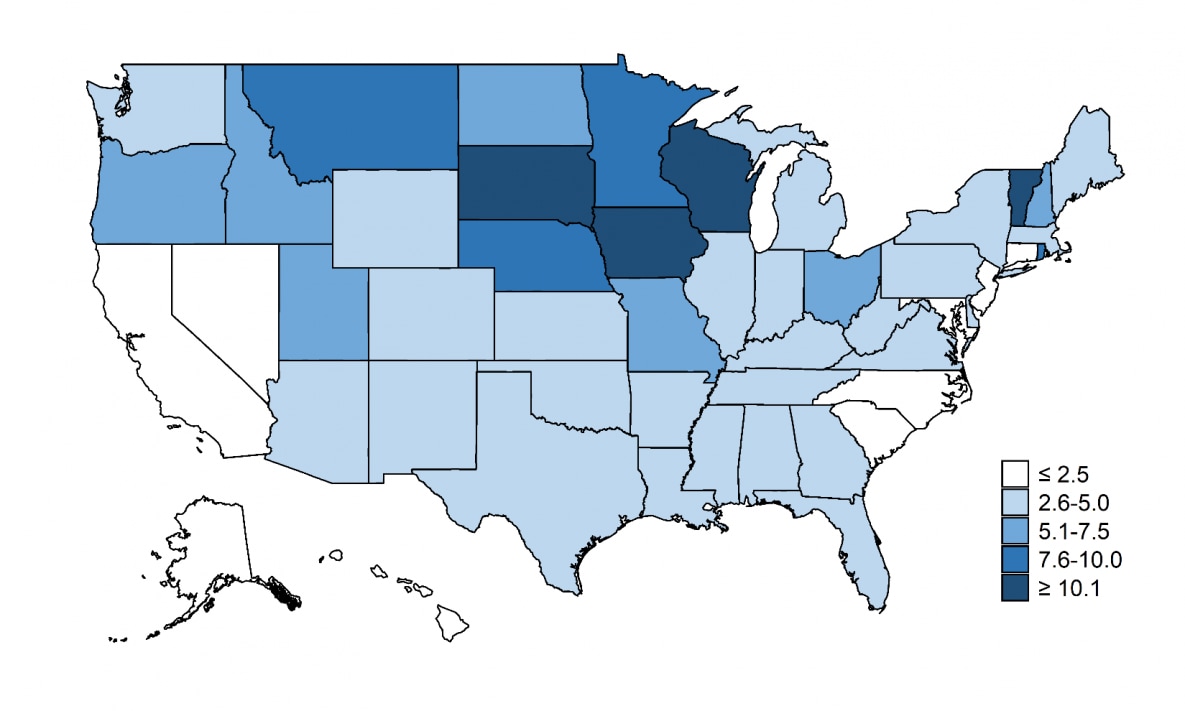
* Cases per 100,000 population
§ New York State and New York City data are mutually exclusive
Cryptosporidiosis is geographically widespread across the United States. Although incidence appears to be consistently higher in the northern Midwest states, differences in incidence might reflect differences in risk factors or modes of transmission of Cryptosporidium; the magnitude of outbreaks; or the capacity or requirements to detect, investigate, and report cases.
Table 2. Number and percentage* of cryptosporidiosis cases, by selected patient demographic characteristics — National Notifiable Diseases Surveillance System, United States, 2018 (n=12,540)
| Characteristic | No. | % |
|---|---|---|
| Sex | ||
| Male | 6,042 | 48.2 |
| Female | 6,479 | 51.7 |
| Missing | 19 | 0.2 |
| Race | ||
| American Indian/Alaska Native | 68 | 0.5 |
| Asian/Pacific Islander | 192 | 1.5 |
| Black | 941 | 7.5 |
| White | 8,841 | 70.5 |
| Other | 665 | 5.3 |
| Missing | 1,833 | 14.6 |
| Ethnicity | ||
| Hispanic | 1,149 | 9.2 |
| Non-Hispanic | 8,190 | 65.3 |
| Missing | 3,201 | 25.5 |
| Total | 12,540 | 100.0 |
* Percentages might not total 100% because of rounding
More than half of patients (6,479 [51.7%]) were female. Of the 10,707 patients for whom race was reported, 82.6% were white. Of the 9,339 patients for whom ethnicity was reported, 12.3% were Hispanic.
Figure 3. Incidence* of cryptosporidiosis cases, by age group — National Notifiable Diseases Surveillance System, United States, 2018 (n=12,534 §)
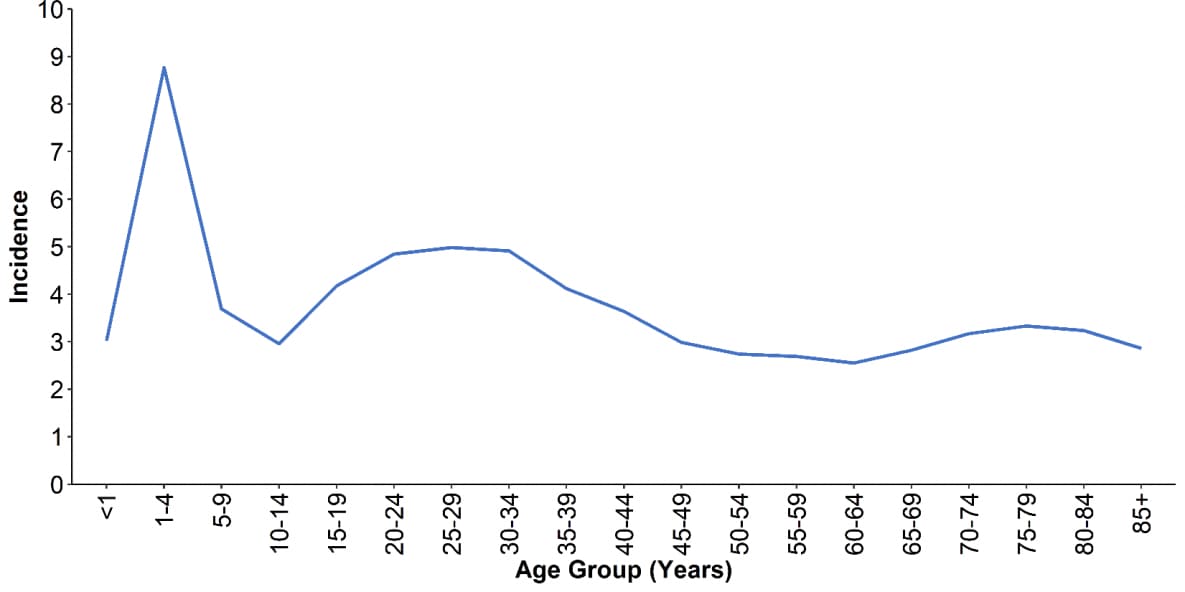
* Cases per 100,000 population
§ Age data missing for 6 patients
The incidence of cryptosporidiosis cases was highest among patients ages 1–4 years (8.8 cases per 100,000 population), 25–29 years (5.0), 30–34 years (4.9), and 20–24 years (4.8). This might reflect young children becoming infected and ill and their caregivers subsequently becoming infected after changing diapers of young children or helping them with toileting.
Figure 4. Incidence* of cryptosporidiosis cases, by sex and age group — National Notifiable Diseases Surveillance System, United States, 2018 (n=12,515 §)
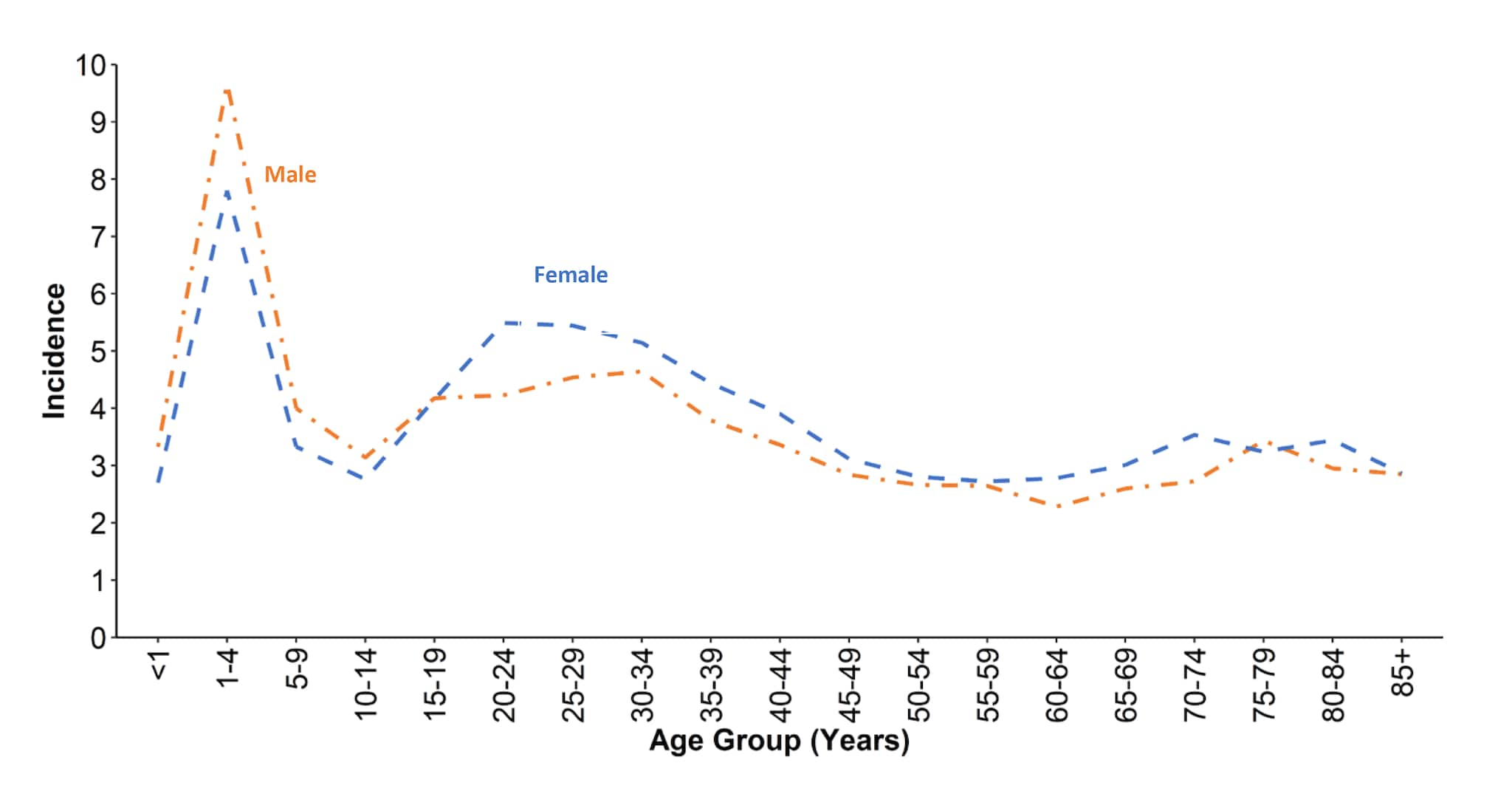
* Cases per 100,000 population
§ Age or sex data missing for 25 patients
Among both males and females, the highest incidence of cryptosporidiosis was among those ages 1–4 years (9.7 and 7.8 cases per 100,000 population for males and females, respectively). Rates for females were higher than for males for all age groups >19 years, except the 75-79 age group. Differences in age-specific incidence might be due to age-specific differences in risk factors or modes of transmission of Cryptosporidium. For example, compared with males, females might be more likely to change diapers of young children or help them with toileting, and thus, more likely to be exposed to Cryptosporidium. Additionally, compared with males, females might be more likely to seek healthcare, and thus, more likely to have illness diagnosed and reported as cryptosporidiosis.
Figure 5. Number of cryptosporidiosis cases, by month of symptom onset — National Notifiable Diseases Surveillance System, United States, 2018 (n=10,328 *)
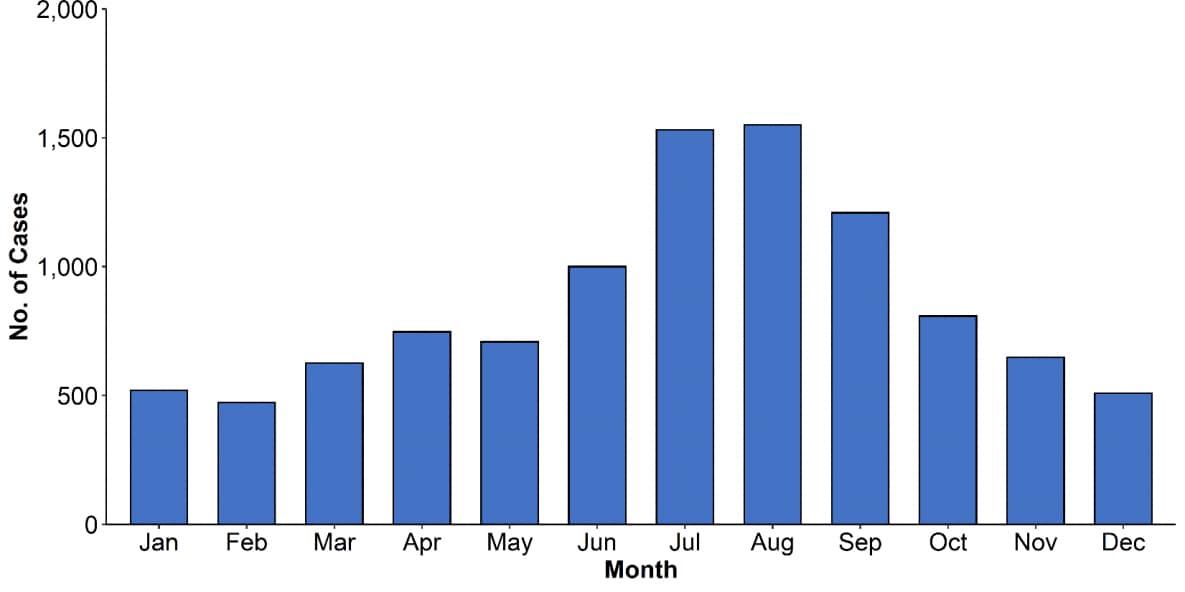
* Month of symptom onset data missing for 2,212 patients
The number of cryptosporidiosis cases was greatest in August (n=1,550) and lowest in February (n=473). The number of cases by month of symptom onset reflect seasonal differences in exposure, such as summertime swimming.
- Hlavsa MC, Cikesh BL, Roberts VA, et al. Outbreaks associated with treated recreational water — United States, 2000–2014. MMWR Morb Mortal Wkly Rep 2018;67:547–551. DOI: http://dx.doi.org/10.15585/mmwr.mm6719a3external icon.
- Hale RH, Scallan E, Cronquist AB, et al., Estimates of enteric illness attributable to contact with animals and their environments in the United States, Clinical Infect Dis 2012:54:472–9. DOI: https://doi.org/10.1093/cid/cis051external icon.
- Scallan E, Hoekstra RM, Angulo FJ, et al. Foodborne illness acquired in the United States—major pathogens. Emerg Infect Dis 2011;17:7–15. DOI: 3201/eid1701.P11101external icon.
- Hunter PR, Hughes S, Woodhouse S, et al. Sporadic cryptosporidiosis case-control study with genotyping. Emerg Infect Dis 2004;10:1241–9. DOI: 3201/eid1007.030582.
- US Census Bureau. Annual Estimates of the Resident Population for Incorporated Places of 50,000 or More, Ranked by July 1, 2018 Population: April 1, 2010 to July 1, 2018. Washington, DC: US Census Bureau; Release Date: May 2019. Available at https://www.census.gov/content/census/en/data/tables/time-series/demo/popest/2010s-total-cities-and-towns.htmlexternal icon
- United States Department of Health and Human Services (US DHHS), Centers for Disease Control and Prevention (CDC), National Center for Health Statistics (NCHS), Bridged-Race Population Estimates, United States July 1st resident population by state, county, age, sex, bridged-race, and Hispanic origin. Compiled from 1990–1999 bridged-race intercensal population estimates (released by NCHS on 7/26/2004); revised bridged-race 2000–2009 intercensal population estimates (released by NCHS on 10/26/2012); and bridged-race Vintage 2018 (2010–2018) postcensal population estimates (released by NCHS on 6/25/2019). Available on CDC WONDER Online Database. Accessed at https://wonder.cdc.gov/Bridged-Race-v2018.HTML on Oct 16, 2019.
- US Census Bureau. Census regions and divisions of the United States. Washington, DC: US Department of Commerce Economics and Statistics Administration, US Census Bureau. Available at https://www2.census.gov/geo/pdfs/maps-data/maps/reference/us_regdiv.pdf pdf icon[PDF – 2 pages]external icon.
Centers for Disease Control and Prevention (CDC). Cryptosporidiosis Summary Report — National Notifiable Diseases Surveillance System, United States, 2018. Atlanta, Georgia: U.S. Department of Health and Human Services, CDC, 2019.